Healthcare System in New Zealand: BN 601 Portfolio Analysis
VerifiedAdded on 2023/01/19
|17
|4488
|46
Report
AI Summary
This report provides a comprehensive analysis of the New Zealand healthcare system, examining its structure, key components, and effectiveness in addressing various health issues. It delves into the roles of the Ministry of Health, District Health Boards (DHBs), and other agencies in shaping healthcare policies and delivering services. The report specifically addresses the importance of sexual and reproductive health strategies, highlighting the impact of sexually transmitted infections (STIs) like chlamydia, particularly among young Maori populations. It explores factors influencing healthcare access for this demographic, including consumer-level barriers, healthcare processes, and organizational aspects. The report further discusses the New Zealand Sexual and Reproductive Health Strategy 2001, its principles, and its influence on healthcare practices, including the role of nurses in providing care and promoting health. The analysis incorporates relevant legislation, such as the New Zealand Public Health and Disability Act 2000, and emphasizes the application of the Treaty of Waitangi principles in healthcare delivery. Overall, the report provides a detailed overview of the New Zealand healthcare system and its implications for nursing practice.
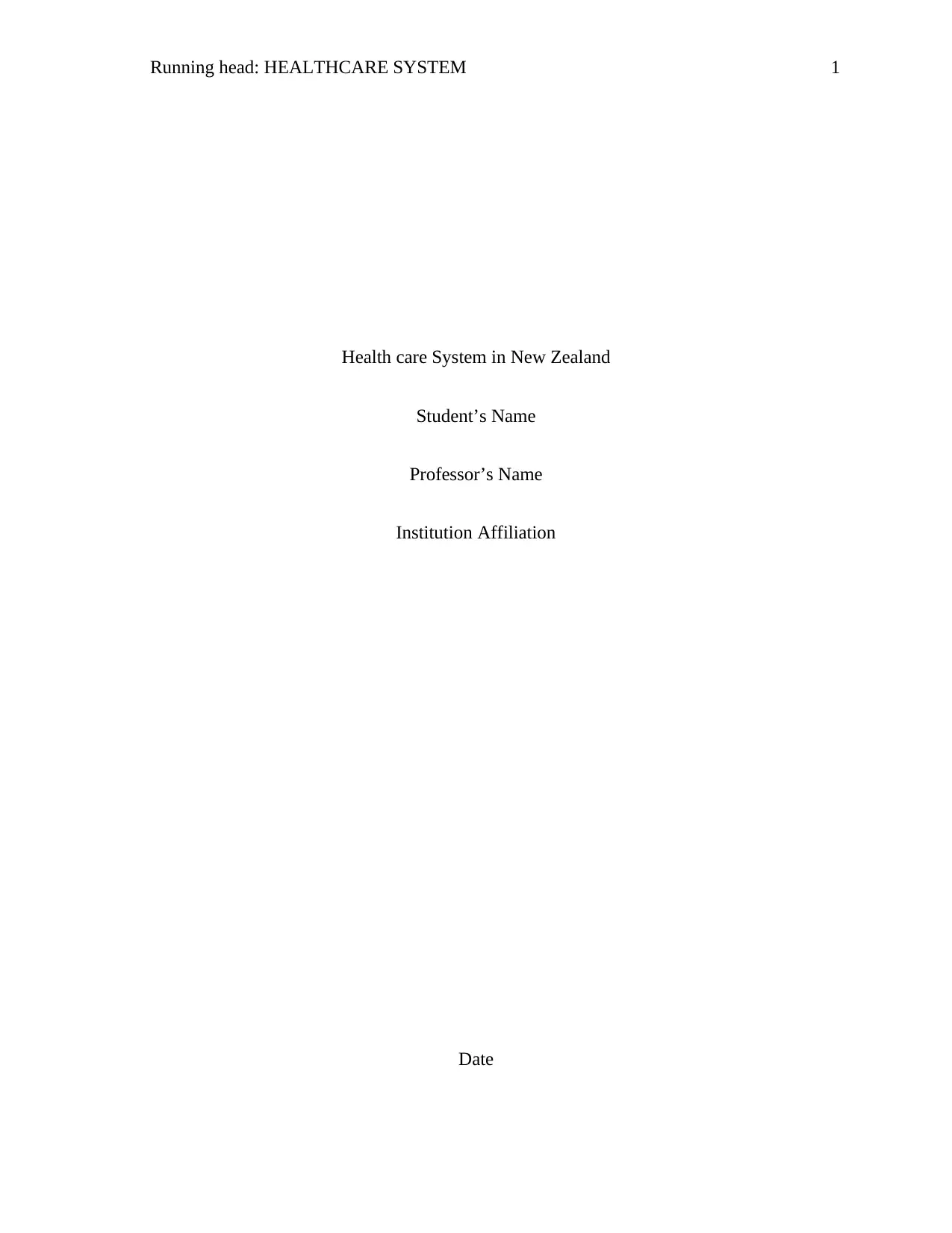
Running head: HEALTHCARE SYSTEM 1
Health care System in New Zealand
Student’s Name
Professor’s Name
Institution Affiliation
Date
Health care System in New Zealand
Student’s Name
Professor’s Name
Institution Affiliation
Date
Paraphrase This Document
Need a fresh take? Get an instant paraphrase of this document with our AI Paraphraser
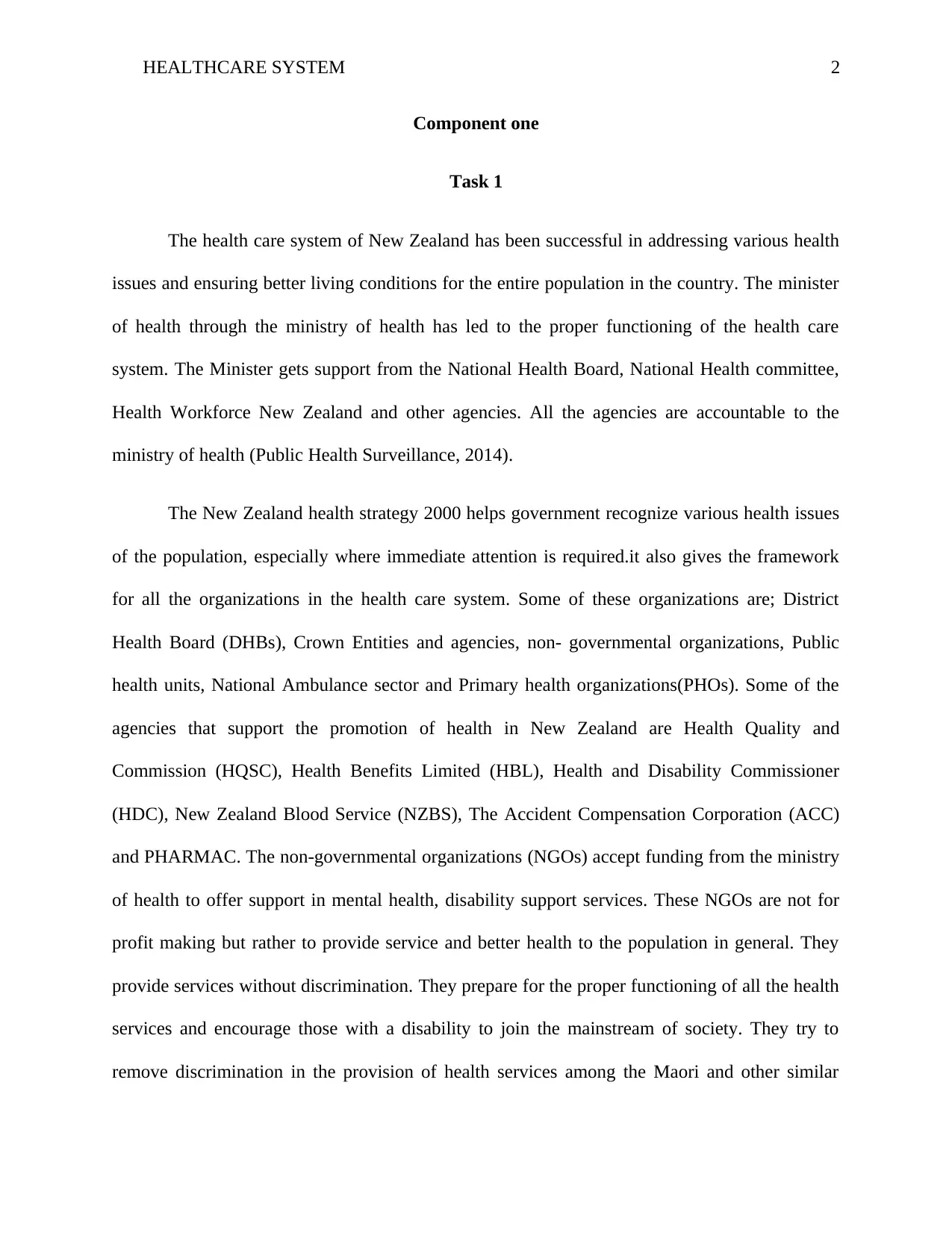
HEALTHCARE SYSTEM 2
Component one
Task 1
The health care system of New Zealand has been successful in addressing various health
issues and ensuring better living conditions for the entire population in the country. The minister
of health through the ministry of health has led to the proper functioning of the health care
system. The Minister gets support from the National Health Board, National Health committee,
Health Workforce New Zealand and other agencies. All the agencies are accountable to the
ministry of health (Public Health Surveillance, 2014).
The New Zealand health strategy 2000 helps government recognize various health issues
of the population, especially where immediate attention is required.it also gives the framework
for all the organizations in the health care system. Some of these organizations are; District
Health Board (DHBs), Crown Entities and agencies, non- governmental organizations, Public
health units, National Ambulance sector and Primary health organizations(PHOs). Some of the
agencies that support the promotion of health in New Zealand are Health Quality and
Commission (HQSC), Health Benefits Limited (HBL), Health and Disability Commissioner
(HDC), New Zealand Blood Service (NZBS), The Accident Compensation Corporation (ACC)
and PHARMAC. The non-governmental organizations (NGOs) accept funding from the ministry
of health to offer support in mental health, disability support services. These NGOs are not for
profit making but rather to provide service and better health to the population in general. They
provide services without discrimination. They prepare for the proper functioning of all the health
services and encourage those with a disability to join the mainstream of society. They try to
remove discrimination in the provision of health services among the Maori and other similar
Component one
Task 1
The health care system of New Zealand has been successful in addressing various health
issues and ensuring better living conditions for the entire population in the country. The minister
of health through the ministry of health has led to the proper functioning of the health care
system. The Minister gets support from the National Health Board, National Health committee,
Health Workforce New Zealand and other agencies. All the agencies are accountable to the
ministry of health (Public Health Surveillance, 2014).
The New Zealand health strategy 2000 helps government recognize various health issues
of the population, especially where immediate attention is required.it also gives the framework
for all the organizations in the health care system. Some of these organizations are; District
Health Board (DHBs), Crown Entities and agencies, non- governmental organizations, Public
health units, National Ambulance sector and Primary health organizations(PHOs). Some of the
agencies that support the promotion of health in New Zealand are Health Quality and
Commission (HQSC), Health Benefits Limited (HBL), Health and Disability Commissioner
(HDC), New Zealand Blood Service (NZBS), The Accident Compensation Corporation (ACC)
and PHARMAC. The non-governmental organizations (NGOs) accept funding from the ministry
of health to offer support in mental health, disability support services. These NGOs are not for
profit making but rather to provide service and better health to the population in general. They
provide services without discrimination. They prepare for the proper functioning of all the health
services and encourage those with a disability to join the mainstream of society. They try to
remove discrimination in the provision of health services among the Maori and other similar
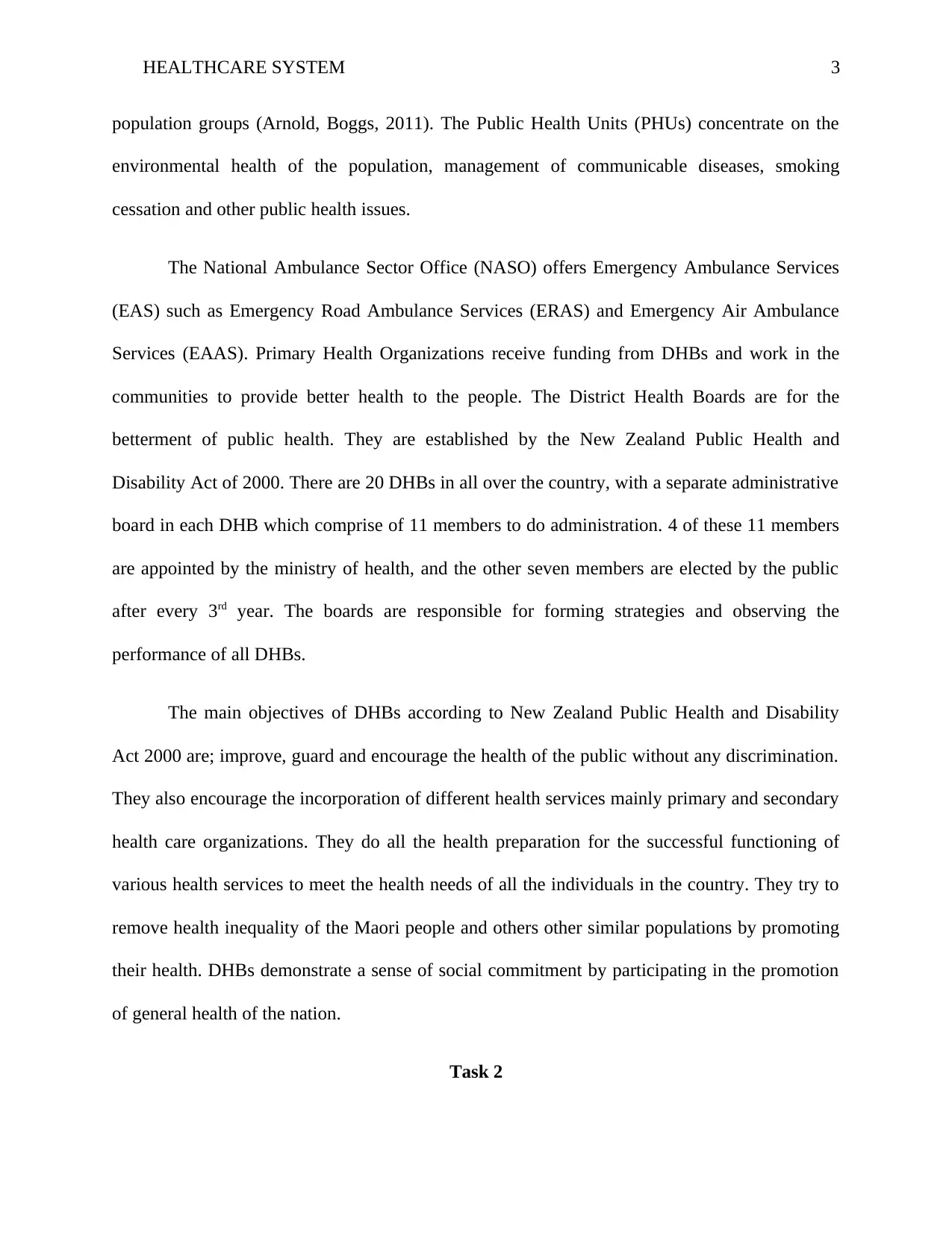
HEALTHCARE SYSTEM 3
population groups (Arnold, Boggs, 2011). The Public Health Units (PHUs) concentrate on the
environmental health of the population, management of communicable diseases, smoking
cessation and other public health issues.
The National Ambulance Sector Office (NASO) offers Emergency Ambulance Services
(EAS) such as Emergency Road Ambulance Services (ERAS) and Emergency Air Ambulance
Services (EAAS). Primary Health Organizations receive funding from DHBs and work in the
communities to provide better health to the people. The District Health Boards are for the
betterment of public health. They are established by the New Zealand Public Health and
Disability Act of 2000. There are 20 DHBs in all over the country, with a separate administrative
board in each DHB which comprise of 11 members to do administration. 4 of these 11 members
are appointed by the ministry of health, and the other seven members are elected by the public
after every 3rd year. The boards are responsible for forming strategies and observing the
performance of all DHBs.
The main objectives of DHBs according to New Zealand Public Health and Disability
Act 2000 are; improve, guard and encourage the health of the public without any discrimination.
They also encourage the incorporation of different health services mainly primary and secondary
health care organizations. They do all the health preparation for the successful functioning of
various health services to meet the health needs of all the individuals in the country. They try to
remove health inequality of the Maori people and others other similar populations by promoting
their health. DHBs demonstrate a sense of social commitment by participating in the promotion
of general health of the nation.
Task 2
population groups (Arnold, Boggs, 2011). The Public Health Units (PHUs) concentrate on the
environmental health of the population, management of communicable diseases, smoking
cessation and other public health issues.
The National Ambulance Sector Office (NASO) offers Emergency Ambulance Services
(EAS) such as Emergency Road Ambulance Services (ERAS) and Emergency Air Ambulance
Services (EAAS). Primary Health Organizations receive funding from DHBs and work in the
communities to provide better health to the people. The District Health Boards are for the
betterment of public health. They are established by the New Zealand Public Health and
Disability Act of 2000. There are 20 DHBs in all over the country, with a separate administrative
board in each DHB which comprise of 11 members to do administration. 4 of these 11 members
are appointed by the ministry of health, and the other seven members are elected by the public
after every 3rd year. The boards are responsible for forming strategies and observing the
performance of all DHBs.
The main objectives of DHBs according to New Zealand Public Health and Disability
Act 2000 are; improve, guard and encourage the health of the public without any discrimination.
They also encourage the incorporation of different health services mainly primary and secondary
health care organizations. They do all the health preparation for the successful functioning of
various health services to meet the health needs of all the individuals in the country. They try to
remove health inequality of the Maori people and others other similar populations by promoting
their health. DHBs demonstrate a sense of social commitment by participating in the promotion
of general health of the nation.
Task 2
⊘ This is a preview!⊘
Do you want full access?
Subscribe today to unlock all pages.

Trusted by 1+ million students worldwide
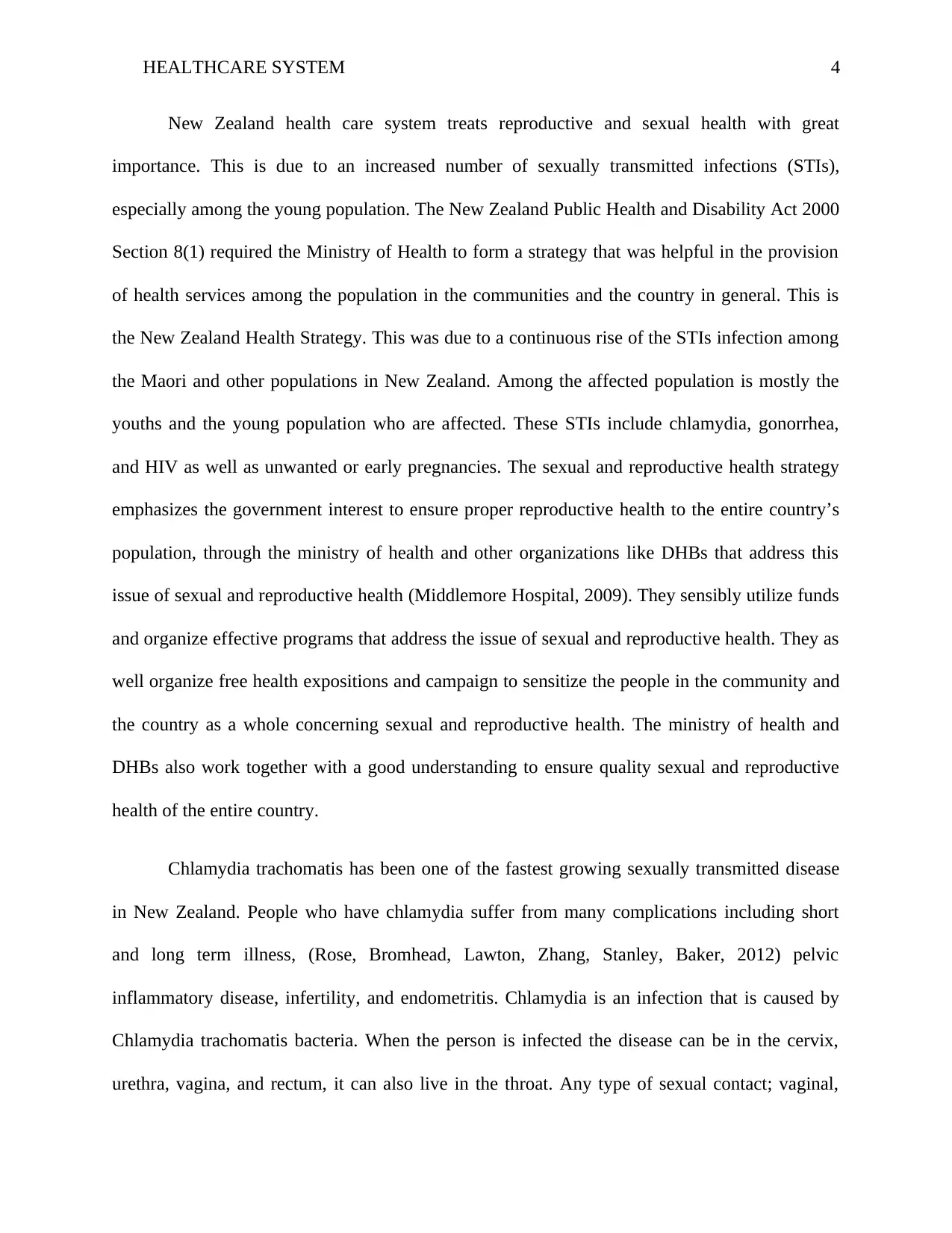
HEALTHCARE SYSTEM 4
New Zealand health care system treats reproductive and sexual health with great
importance. This is due to an increased number of sexually transmitted infections (STIs),
especially among the young population. The New Zealand Public Health and Disability Act 2000
Section 8(1) required the Ministry of Health to form a strategy that was helpful in the provision
of health services among the population in the communities and the country in general. This is
the New Zealand Health Strategy. This was due to a continuous rise of the STIs infection among
the Maori and other populations in New Zealand. Among the affected population is mostly the
youths and the young population who are affected. These STIs include chlamydia, gonorrhea,
and HIV as well as unwanted or early pregnancies. The sexual and reproductive health strategy
emphasizes the government interest to ensure proper reproductive health to the entire country’s
population, through the ministry of health and other organizations like DHBs that address this
issue of sexual and reproductive health (Middlemore Hospital, 2009). They sensibly utilize funds
and organize effective programs that address the issue of sexual and reproductive health. They as
well organize free health expositions and campaign to sensitize the people in the community and
the country as a whole concerning sexual and reproductive health. The ministry of health and
DHBs also work together with a good understanding to ensure quality sexual and reproductive
health of the entire country.
Chlamydia trachomatis has been one of the fastest growing sexually transmitted disease
in New Zealand. People who have chlamydia suffer from many complications including short
and long term illness, (Rose, Bromhead, Lawton, Zhang, Stanley, Baker, 2012) pelvic
inflammatory disease, infertility, and endometritis. Chlamydia is an infection that is caused by
Chlamydia trachomatis bacteria. When the person is infected the disease can be in the cervix,
urethra, vagina, and rectum, it can also live in the throat. Any type of sexual contact; vaginal,
New Zealand health care system treats reproductive and sexual health with great
importance. This is due to an increased number of sexually transmitted infections (STIs),
especially among the young population. The New Zealand Public Health and Disability Act 2000
Section 8(1) required the Ministry of Health to form a strategy that was helpful in the provision
of health services among the population in the communities and the country in general. This is
the New Zealand Health Strategy. This was due to a continuous rise of the STIs infection among
the Maori and other populations in New Zealand. Among the affected population is mostly the
youths and the young population who are affected. These STIs include chlamydia, gonorrhea,
and HIV as well as unwanted or early pregnancies. The sexual and reproductive health strategy
emphasizes the government interest to ensure proper reproductive health to the entire country’s
population, through the ministry of health and other organizations like DHBs that address this
issue of sexual and reproductive health (Middlemore Hospital, 2009). They sensibly utilize funds
and organize effective programs that address the issue of sexual and reproductive health. They as
well organize free health expositions and campaign to sensitize the people in the community and
the country as a whole concerning sexual and reproductive health. The ministry of health and
DHBs also work together with a good understanding to ensure quality sexual and reproductive
health of the entire country.
Chlamydia trachomatis has been one of the fastest growing sexually transmitted disease
in New Zealand. People who have chlamydia suffer from many complications including short
and long term illness, (Rose, Bromhead, Lawton, Zhang, Stanley, Baker, 2012) pelvic
inflammatory disease, infertility, and endometritis. Chlamydia is an infection that is caused by
Chlamydia trachomatis bacteria. When the person is infected the disease can be in the cervix,
urethra, vagina, and rectum, it can also live in the throat. Any type of sexual contact; vaginal,
Paraphrase This Document
Need a fresh take? Get an instant paraphrase of this document with our AI Paraphraser
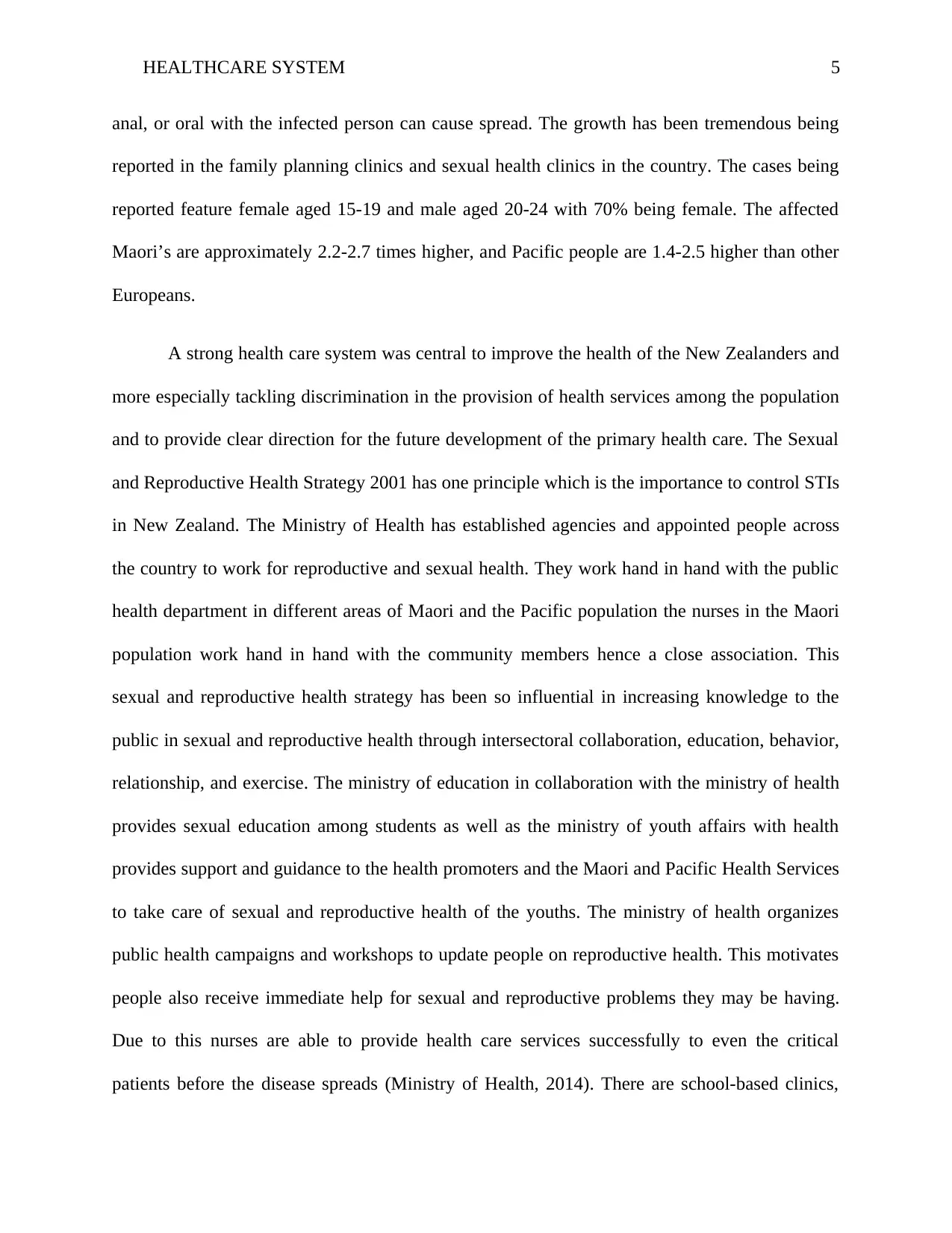
HEALTHCARE SYSTEM 5
anal, or oral with the infected person can cause spread. The growth has been tremendous being
reported in the family planning clinics and sexual health clinics in the country. The cases being
reported feature female aged 15-19 and male aged 20-24 with 70% being female. The affected
Maori’s are approximately 2.2-2.7 times higher, and Pacific people are 1.4-2.5 higher than other
Europeans.
A strong health care system was central to improve the health of the New Zealanders and
more especially tackling discrimination in the provision of health services among the population
and to provide clear direction for the future development of the primary health care. The Sexual
and Reproductive Health Strategy 2001 has one principle which is the importance to control STIs
in New Zealand. The Ministry of Health has established agencies and appointed people across
the country to work for reproductive and sexual health. They work hand in hand with the public
health department in different areas of Maori and the Pacific population the nurses in the Maori
population work hand in hand with the community members hence a close association. This
sexual and reproductive health strategy has been so influential in increasing knowledge to the
public in sexual and reproductive health through intersectoral collaboration, education, behavior,
relationship, and exercise. The ministry of education in collaboration with the ministry of health
provides sexual education among students as well as the ministry of youth affairs with health
provides support and guidance to the health promoters and the Maori and Pacific Health Services
to take care of sexual and reproductive health of the youths. The ministry of health organizes
public health campaigns and workshops to update people on reproductive health. This motivates
people also receive immediate help for sexual and reproductive problems they may be having.
Due to this nurses are able to provide health care services successfully to even the critical
patients before the disease spreads (Ministry of Health, 2014). There are school-based clinics,
anal, or oral with the infected person can cause spread. The growth has been tremendous being
reported in the family planning clinics and sexual health clinics in the country. The cases being
reported feature female aged 15-19 and male aged 20-24 with 70% being female. The affected
Maori’s are approximately 2.2-2.7 times higher, and Pacific people are 1.4-2.5 higher than other
Europeans.
A strong health care system was central to improve the health of the New Zealanders and
more especially tackling discrimination in the provision of health services among the population
and to provide clear direction for the future development of the primary health care. The Sexual
and Reproductive Health Strategy 2001 has one principle which is the importance to control STIs
in New Zealand. The Ministry of Health has established agencies and appointed people across
the country to work for reproductive and sexual health. They work hand in hand with the public
health department in different areas of Maori and the Pacific population the nurses in the Maori
population work hand in hand with the community members hence a close association. This
sexual and reproductive health strategy has been so influential in increasing knowledge to the
public in sexual and reproductive health through intersectoral collaboration, education, behavior,
relationship, and exercise. The ministry of education in collaboration with the ministry of health
provides sexual education among students as well as the ministry of youth affairs with health
provides support and guidance to the health promoters and the Maori and Pacific Health Services
to take care of sexual and reproductive health of the youths. The ministry of health organizes
public health campaigns and workshops to update people on reproductive health. This motivates
people also receive immediate help for sexual and reproductive problems they may be having.
Due to this nurses are able to provide health care services successfully to even the critical
patients before the disease spreads (Ministry of Health, 2014). There are school-based clinics,
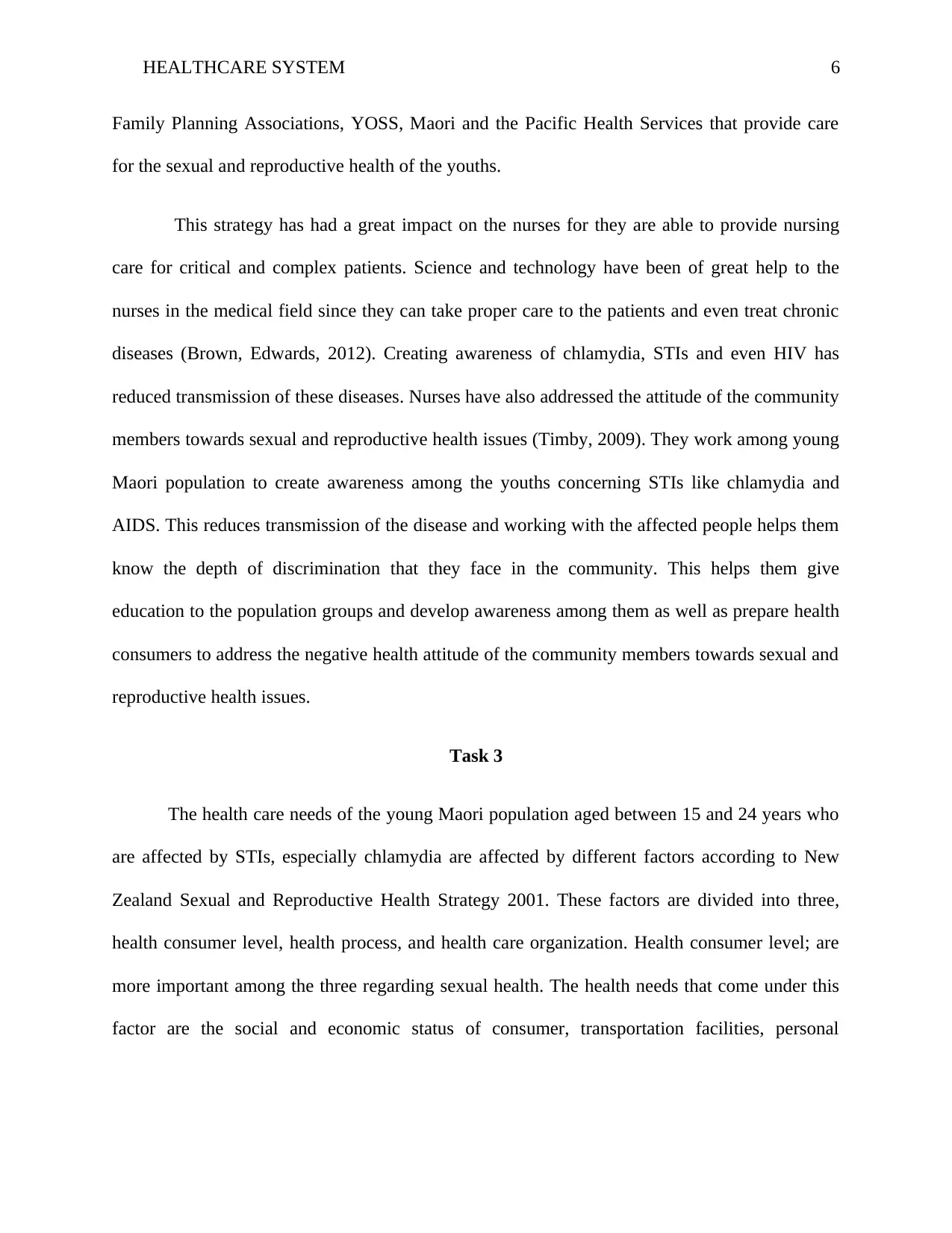
HEALTHCARE SYSTEM 6
Family Planning Associations, YOSS, Maori and the Pacific Health Services that provide care
for the sexual and reproductive health of the youths.
This strategy has had a great impact on the nurses for they are able to provide nursing
care for critical and complex patients. Science and technology have been of great help to the
nurses in the medical field since they can take proper care to the patients and even treat chronic
diseases (Brown, Edwards, 2012). Creating awareness of chlamydia, STIs and even HIV has
reduced transmission of these diseases. Nurses have also addressed the attitude of the community
members towards sexual and reproductive health issues (Timby, 2009). They work among young
Maori population to create awareness among the youths concerning STIs like chlamydia and
AIDS. This reduces transmission of the disease and working with the affected people helps them
know the depth of discrimination that they face in the community. This helps them give
education to the population groups and develop awareness among them as well as prepare health
consumers to address the negative health attitude of the community members towards sexual and
reproductive health issues.
Task 3
The health care needs of the young Maori population aged between 15 and 24 years who
are affected by STIs, especially chlamydia are affected by different factors according to New
Zealand Sexual and Reproductive Health Strategy 2001. These factors are divided into three,
health consumer level, health process, and health care organization. Health consumer level; are
more important among the three regarding sexual health. The health needs that come under this
factor are the social and economic status of consumer, transportation facilities, personal
Family Planning Associations, YOSS, Maori and the Pacific Health Services that provide care
for the sexual and reproductive health of the youths.
This strategy has had a great impact on the nurses for they are able to provide nursing
care for critical and complex patients. Science and technology have been of great help to the
nurses in the medical field since they can take proper care to the patients and even treat chronic
diseases (Brown, Edwards, 2012). Creating awareness of chlamydia, STIs and even HIV has
reduced transmission of these diseases. Nurses have also addressed the attitude of the community
members towards sexual and reproductive health issues (Timby, 2009). They work among young
Maori population to create awareness among the youths concerning STIs like chlamydia and
AIDS. This reduces transmission of the disease and working with the affected people helps them
know the depth of discrimination that they face in the community. This helps them give
education to the population groups and develop awareness among them as well as prepare health
consumers to address the negative health attitude of the community members towards sexual and
reproductive health issues.
Task 3
The health care needs of the young Maori population aged between 15 and 24 years who
are affected by STIs, especially chlamydia are affected by different factors according to New
Zealand Sexual and Reproductive Health Strategy 2001. These factors are divided into three,
health consumer level, health process, and health care organization. Health consumer level; are
more important among the three regarding sexual health. The health needs that come under this
factor are the social and economic status of consumer, transportation facilities, personal
⊘ This is a preview!⊘
Do you want full access?
Subscribe today to unlock all pages.

Trusted by 1+ million students worldwide
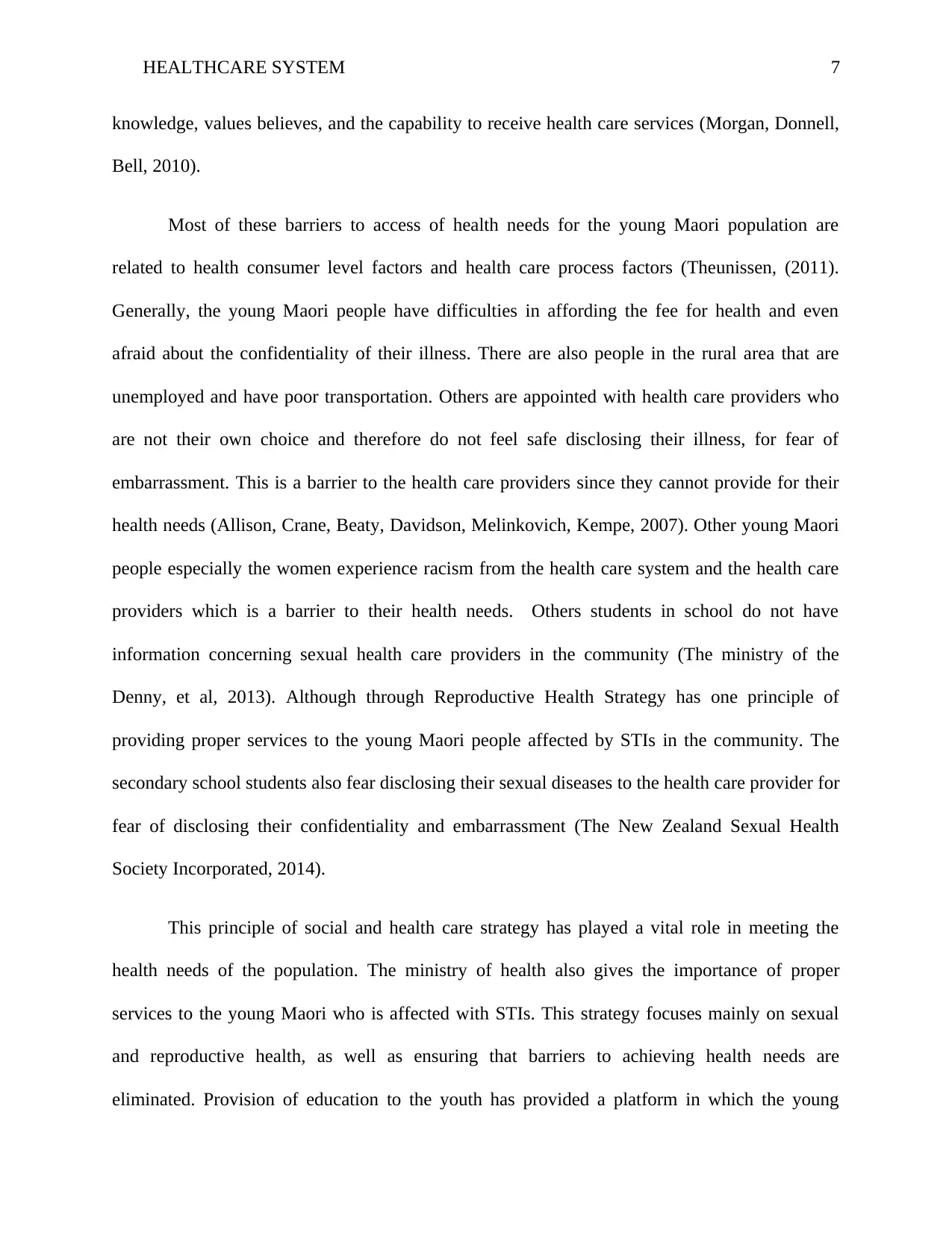
HEALTHCARE SYSTEM 7
knowledge, values believes, and the capability to receive health care services (Morgan, Donnell,
Bell, 2010).
Most of these barriers to access of health needs for the young Maori population are
related to health consumer level factors and health care process factors (Theunissen, (2011).
Generally, the young Maori people have difficulties in affording the fee for health and even
afraid about the confidentiality of their illness. There are also people in the rural area that are
unemployed and have poor transportation. Others are appointed with health care providers who
are not their own choice and therefore do not feel safe disclosing their illness, for fear of
embarrassment. This is a barrier to the health care providers since they cannot provide for their
health needs (Allison, Crane, Beaty, Davidson, Melinkovich, Kempe, 2007). Other young Maori
people especially the women experience racism from the health care system and the health care
providers which is a barrier to their health needs. Others students in school do not have
information concerning sexual health care providers in the community (The ministry of the
Denny, et al, 2013). Although through Reproductive Health Strategy has one principle of
providing proper services to the young Maori people affected by STIs in the community. The
secondary school students also fear disclosing their sexual diseases to the health care provider for
fear of disclosing their confidentiality and embarrassment (The New Zealand Sexual Health
Society Incorporated, 2014).
This principle of social and health care strategy has played a vital role in meeting the
health needs of the population. The ministry of health also gives the importance of proper
services to the young Maori who is affected with STIs. This strategy focuses mainly on sexual
and reproductive health, as well as ensuring that barriers to achieving health needs are
eliminated. Provision of education to the youth has provided a platform in which the young
knowledge, values believes, and the capability to receive health care services (Morgan, Donnell,
Bell, 2010).
Most of these barriers to access of health needs for the young Maori population are
related to health consumer level factors and health care process factors (Theunissen, (2011).
Generally, the young Maori people have difficulties in affording the fee for health and even
afraid about the confidentiality of their illness. There are also people in the rural area that are
unemployed and have poor transportation. Others are appointed with health care providers who
are not their own choice and therefore do not feel safe disclosing their illness, for fear of
embarrassment. This is a barrier to the health care providers since they cannot provide for their
health needs (Allison, Crane, Beaty, Davidson, Melinkovich, Kempe, 2007). Other young Maori
people especially the women experience racism from the health care system and the health care
providers which is a barrier to their health needs. Others students in school do not have
information concerning sexual health care providers in the community (The ministry of the
Denny, et al, 2013). Although through Reproductive Health Strategy has one principle of
providing proper services to the young Maori people affected by STIs in the community. The
secondary school students also fear disclosing their sexual diseases to the health care provider for
fear of disclosing their confidentiality and embarrassment (The New Zealand Sexual Health
Society Incorporated, 2014).
This principle of social and health care strategy has played a vital role in meeting the
health needs of the population. The ministry of health also gives the importance of proper
services to the young Maori who is affected with STIs. This strategy focuses mainly on sexual
and reproductive health, as well as ensuring that barriers to achieving health needs are
eliminated. Provision of education to the youth has provided a platform in which the young
Paraphrase This Document
Need a fresh take? Get an instant paraphrase of this document with our AI Paraphraser
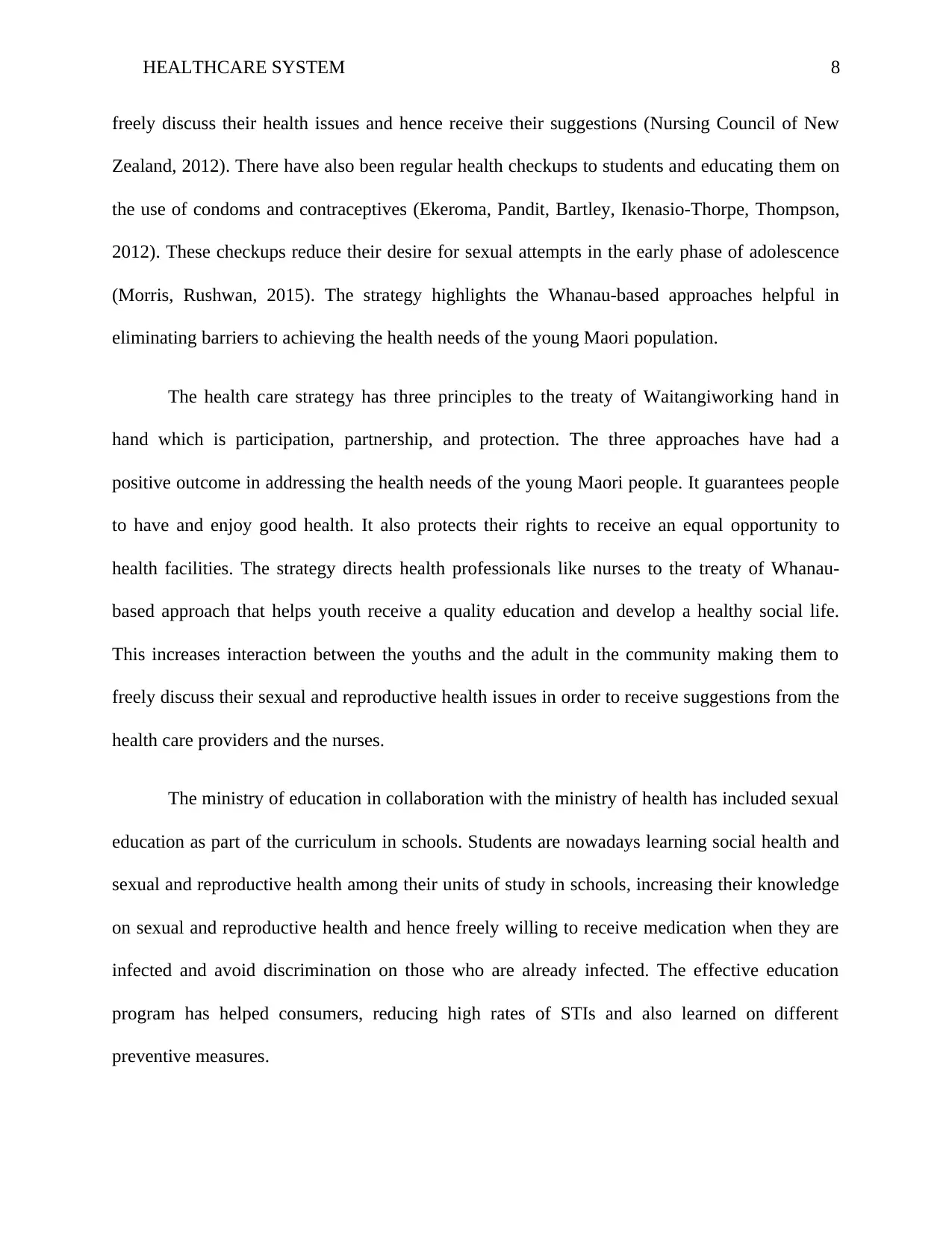
HEALTHCARE SYSTEM 8
freely discuss their health issues and hence receive their suggestions (Nursing Council of New
Zealand, 2012). There have also been regular health checkups to students and educating them on
the use of condoms and contraceptives (Ekeroma, Pandit, Bartley, Ikenasio-Thorpe, Thompson,
2012). These checkups reduce their desire for sexual attempts in the early phase of adolescence
(Morris, Rushwan, 2015). The strategy highlights the Whanau-based approaches helpful in
eliminating barriers to achieving the health needs of the young Maori population.
The health care strategy has three principles to the treaty of Waitangiworking hand in
hand which is participation, partnership, and protection. The three approaches have had a
positive outcome in addressing the health needs of the young Maori people. It guarantees people
to have and enjoy good health. It also protects their rights to receive an equal opportunity to
health facilities. The strategy directs health professionals like nurses to the treaty of Whanau-
based approach that helps youth receive a quality education and develop a healthy social life.
This increases interaction between the youths and the adult in the community making them to
freely discuss their sexual and reproductive health issues in order to receive suggestions from the
health care providers and the nurses.
The ministry of education in collaboration with the ministry of health has included sexual
education as part of the curriculum in schools. Students are nowadays learning social health and
sexual and reproductive health among their units of study in schools, increasing their knowledge
on sexual and reproductive health and hence freely willing to receive medication when they are
infected and avoid discrimination on those who are already infected. The effective education
program has helped consumers, reducing high rates of STIs and also learned on different
preventive measures.
freely discuss their health issues and hence receive their suggestions (Nursing Council of New
Zealand, 2012). There have also been regular health checkups to students and educating them on
the use of condoms and contraceptives (Ekeroma, Pandit, Bartley, Ikenasio-Thorpe, Thompson,
2012). These checkups reduce their desire for sexual attempts in the early phase of adolescence
(Morris, Rushwan, 2015). The strategy highlights the Whanau-based approaches helpful in
eliminating barriers to achieving the health needs of the young Maori population.
The health care strategy has three principles to the treaty of Waitangiworking hand in
hand which is participation, partnership, and protection. The three approaches have had a
positive outcome in addressing the health needs of the young Maori people. It guarantees people
to have and enjoy good health. It also protects their rights to receive an equal opportunity to
health facilities. The strategy directs health professionals like nurses to the treaty of Whanau-
based approach that helps youth receive a quality education and develop a healthy social life.
This increases interaction between the youths and the adult in the community making them to
freely discuss their sexual and reproductive health issues in order to receive suggestions from the
health care providers and the nurses.
The ministry of education in collaboration with the ministry of health has included sexual
education as part of the curriculum in schools. Students are nowadays learning social health and
sexual and reproductive health among their units of study in schools, increasing their knowledge
on sexual and reproductive health and hence freely willing to receive medication when they are
infected and avoid discrimination on those who are already infected. The effective education
program has helped consumers, reducing high rates of STIs and also learned on different
preventive measures.
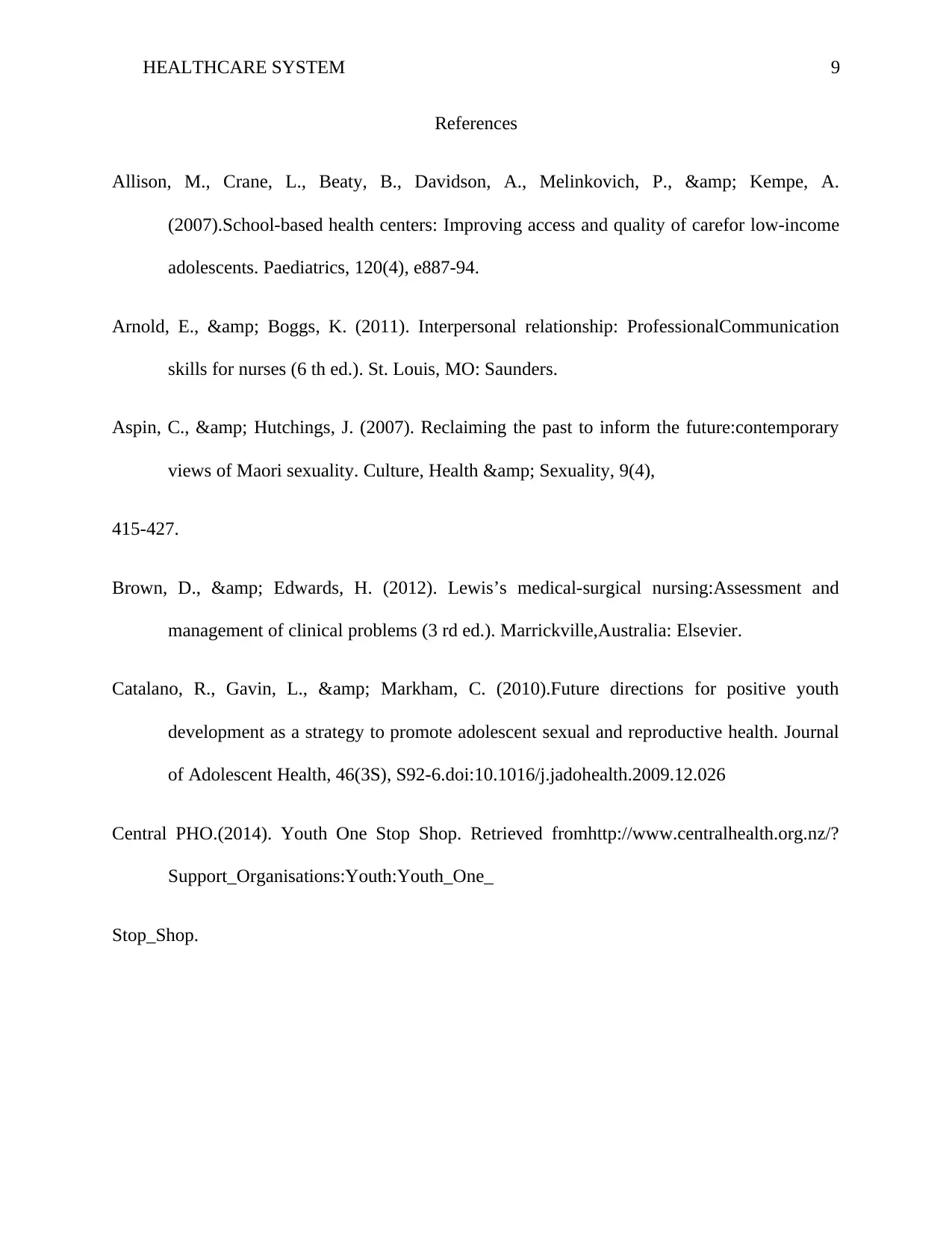
HEALTHCARE SYSTEM 9
References
Allison, M., Crane, L., Beaty, B., Davidson, A., Melinkovich, P., & Kempe, A.
(2007).School-based health centers: Improving access and quality of carefor low-income
adolescents. Paediatrics, 120(4), e887-94.
Arnold, E., & Boggs, K. (2011). Interpersonal relationship: ProfessionalCommunication
skills for nurses (6 th ed.). St. Louis, MO: Saunders.
Aspin, C., & Hutchings, J. (2007). Reclaiming the past to inform the future:contemporary
views of Maori sexuality. Culture, Health & Sexuality, 9(4),
415-427.
Brown, D., & Edwards, H. (2012). Lewis’s medical-surgical nursing:Assessment and
management of clinical problems (3 rd ed.). Marrickville,Australia: Elsevier.
Catalano, R., Gavin, L., & Markham, C. (2010).Future directions for positive youth
development as a strategy to promote adolescent sexual and reproductive health. Journal
of Adolescent Health, 46(3S), S92-6.doi:10.1016/j.jadohealth.2009.12.026
Central PHO.(2014). Youth One Stop Shop. Retrieved fromhttp://www.centralhealth.org.nz/?
Support_Organisations:Youth:Youth_One_
Stop_Shop.
References
Allison, M., Crane, L., Beaty, B., Davidson, A., Melinkovich, P., & Kempe, A.
(2007).School-based health centers: Improving access and quality of carefor low-income
adolescents. Paediatrics, 120(4), e887-94.
Arnold, E., & Boggs, K. (2011). Interpersonal relationship: ProfessionalCommunication
skills for nurses (6 th ed.). St. Louis, MO: Saunders.
Aspin, C., & Hutchings, J. (2007). Reclaiming the past to inform the future:contemporary
views of Maori sexuality. Culture, Health & Sexuality, 9(4),
415-427.
Brown, D., & Edwards, H. (2012). Lewis’s medical-surgical nursing:Assessment and
management of clinical problems (3 rd ed.). Marrickville,Australia: Elsevier.
Catalano, R., Gavin, L., & Markham, C. (2010).Future directions for positive youth
development as a strategy to promote adolescent sexual and reproductive health. Journal
of Adolescent Health, 46(3S), S92-6.doi:10.1016/j.jadohealth.2009.12.026
Central PHO.(2014). Youth One Stop Shop. Retrieved fromhttp://www.centralhealth.org.nz/?
Support_Organisations:Youth:Youth_One_
Stop_Shop.
⊘ This is a preview!⊘
Do you want full access?
Subscribe today to unlock all pages.

Trusted by 1+ million students worldwide
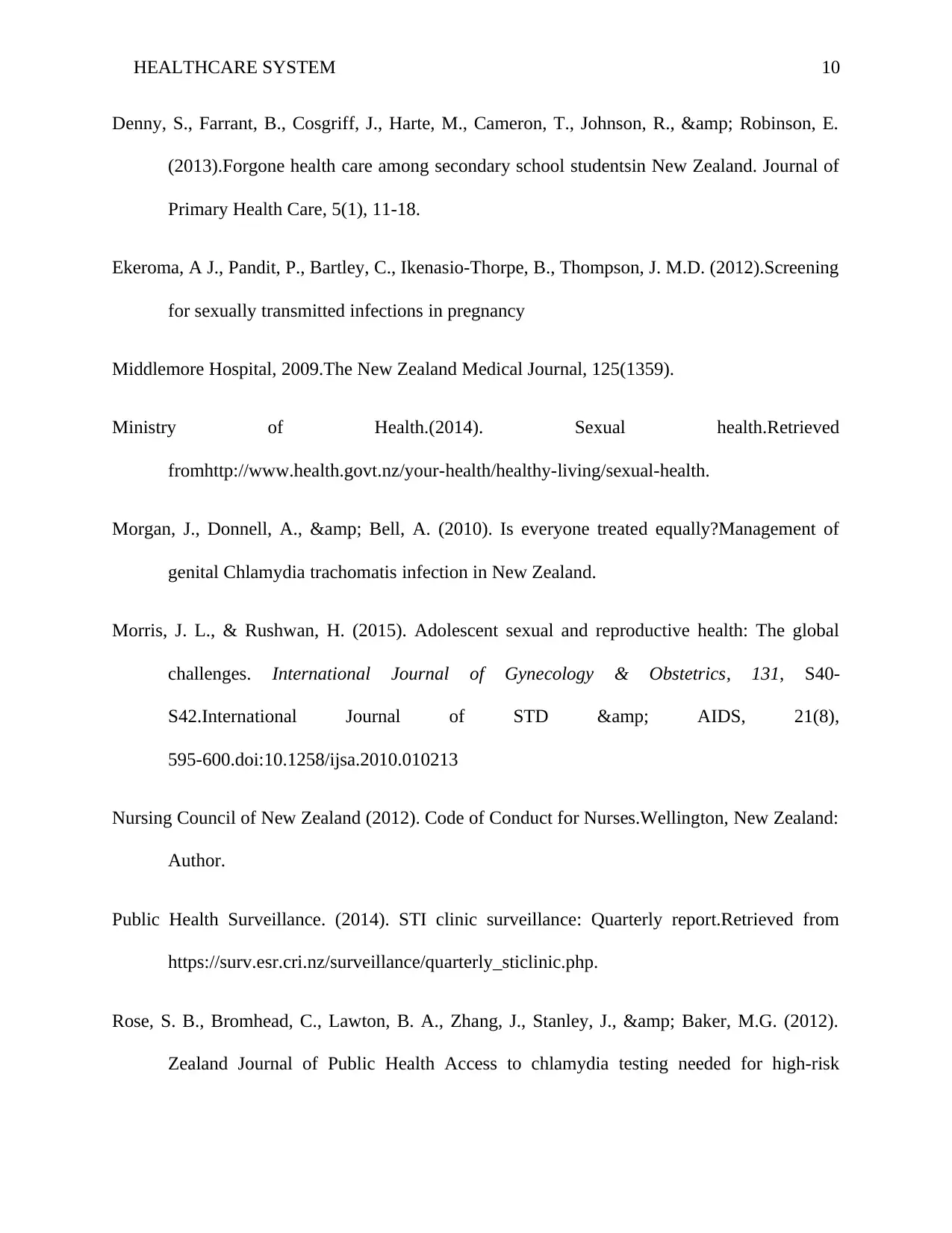
HEALTHCARE SYSTEM 10
Denny, S., Farrant, B., Cosgriff, J., Harte, M., Cameron, T., Johnson, R., & Robinson, E.
(2013).Forgone health care among secondary school studentsin New Zealand. Journal of
Primary Health Care, 5(1), 11-18.
Ekeroma, A J., Pandit, P., Bartley, C., Ikenasio-Thorpe, B., Thompson, J. M.D. (2012).Screening
for sexually transmitted infections in pregnancy
Middlemore Hospital, 2009.The New Zealand Medical Journal, 125(1359).
Ministry of Health.(2014). Sexual health.Retrieved
fromhttp://www.health.govt.nz/your-health/healthy-living/sexual-health.
Morgan, J., Donnell, A., & Bell, A. (2010). Is everyone treated equally?Management of
genital Chlamydia trachomatis infection in New Zealand.
Morris, J. L., & Rushwan, H. (2015). Adolescent sexual and reproductive health: The global
challenges. International Journal of Gynecology & Obstetrics, 131, S40-
S42.International Journal of STD & AIDS, 21(8),
595-600.doi:10.1258/ijsa.2010.010213
Nursing Council of New Zealand (2012). Code of Conduct for Nurses.Wellington, New Zealand:
Author.
Public Health Surveillance. (2014). STI clinic surveillance: Quarterly report.Retrieved from
https://surv.esr.cri.nz/surveillance/quarterly_sticlinic.php.
Rose, S. B., Bromhead, C., Lawton, B. A., Zhang, J., Stanley, J., & Baker, M.G. (2012).
Zealand Journal of Public Health Access to chlamydia testing needed for high-risk
Denny, S., Farrant, B., Cosgriff, J., Harte, M., Cameron, T., Johnson, R., & Robinson, E.
(2013).Forgone health care among secondary school studentsin New Zealand. Journal of
Primary Health Care, 5(1), 11-18.
Ekeroma, A J., Pandit, P., Bartley, C., Ikenasio-Thorpe, B., Thompson, J. M.D. (2012).Screening
for sexually transmitted infections in pregnancy
Middlemore Hospital, 2009.The New Zealand Medical Journal, 125(1359).
Ministry of Health.(2014). Sexual health.Retrieved
fromhttp://www.health.govt.nz/your-health/healthy-living/sexual-health.
Morgan, J., Donnell, A., & Bell, A. (2010). Is everyone treated equally?Management of
genital Chlamydia trachomatis infection in New Zealand.
Morris, J. L., & Rushwan, H. (2015). Adolescent sexual and reproductive health: The global
challenges. International Journal of Gynecology & Obstetrics, 131, S40-
S42.International Journal of STD & AIDS, 21(8),
595-600.doi:10.1258/ijsa.2010.010213
Nursing Council of New Zealand (2012). Code of Conduct for Nurses.Wellington, New Zealand:
Author.
Public Health Surveillance. (2014). STI clinic surveillance: Quarterly report.Retrieved from
https://surv.esr.cri.nz/surveillance/quarterly_sticlinic.php.
Rose, S. B., Bromhead, C., Lawton, B. A., Zhang, J., Stanley, J., & Baker, M.G. (2012).
Zealand Journal of Public Health Access to chlamydia testing needed for high-risk
Paraphrase This Document
Need a fresh take? Get an instant paraphrase of this document with our AI Paraphraser
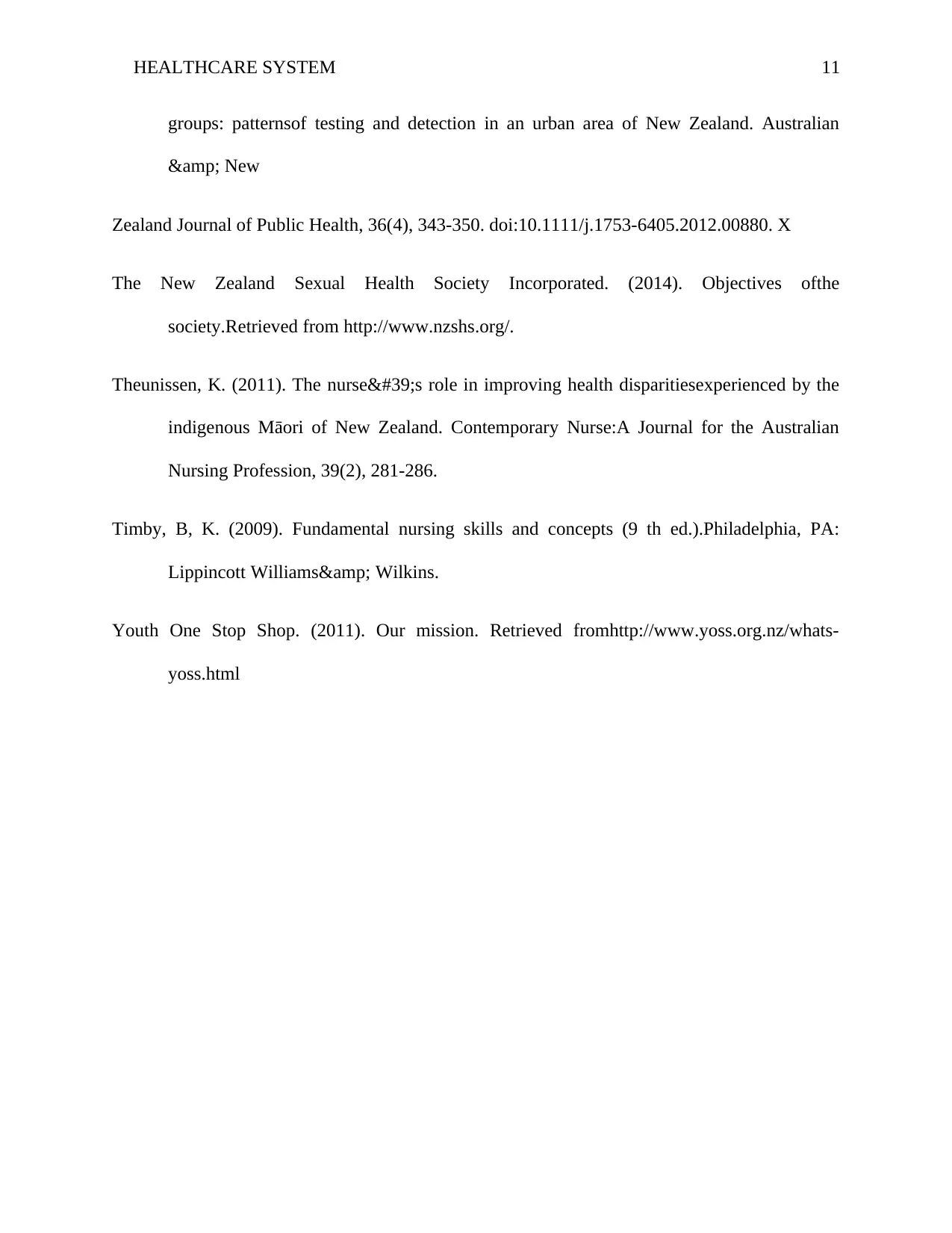
HEALTHCARE SYSTEM 11
groups: patternsof testing and detection in an urban area of New Zealand. Australian
& New
Zealand Journal of Public Health, 36(4), 343-350. doi:10.1111/j.1753-6405.2012.00880. X
The New Zealand Sexual Health Society Incorporated. (2014). Objectives ofthe
society.Retrieved from http://www.nzshs.org/.
Theunissen, K. (2011). The nurse's role in improving health disparitiesexperienced by the
indigenous Māori of New Zealand. Contemporary Nurse:A Journal for the Australian
Nursing Profession, 39(2), 281-286.
Timby, B, K. (2009). Fundamental nursing skills and concepts (9 th ed.).Philadelphia, PA:
Lippincott Williams& Wilkins.
Youth One Stop Shop. (2011). Our mission. Retrieved fromhttp://www.yoss.org.nz/whats-
yoss.html
groups: patternsof testing and detection in an urban area of New Zealand. Australian
& New
Zealand Journal of Public Health, 36(4), 343-350. doi:10.1111/j.1753-6405.2012.00880. X
The New Zealand Sexual Health Society Incorporated. (2014). Objectives ofthe
society.Retrieved from http://www.nzshs.org/.
Theunissen, K. (2011). The nurse's role in improving health disparitiesexperienced by the
indigenous Māori of New Zealand. Contemporary Nurse:A Journal for the Australian
Nursing Profession, 39(2), 281-286.
Timby, B, K. (2009). Fundamental nursing skills and concepts (9 th ed.).Philadelphia, PA:
Lippincott Williams& Wilkins.
Youth One Stop Shop. (2011). Our mission. Retrieved fromhttp://www.yoss.org.nz/whats-
yoss.html
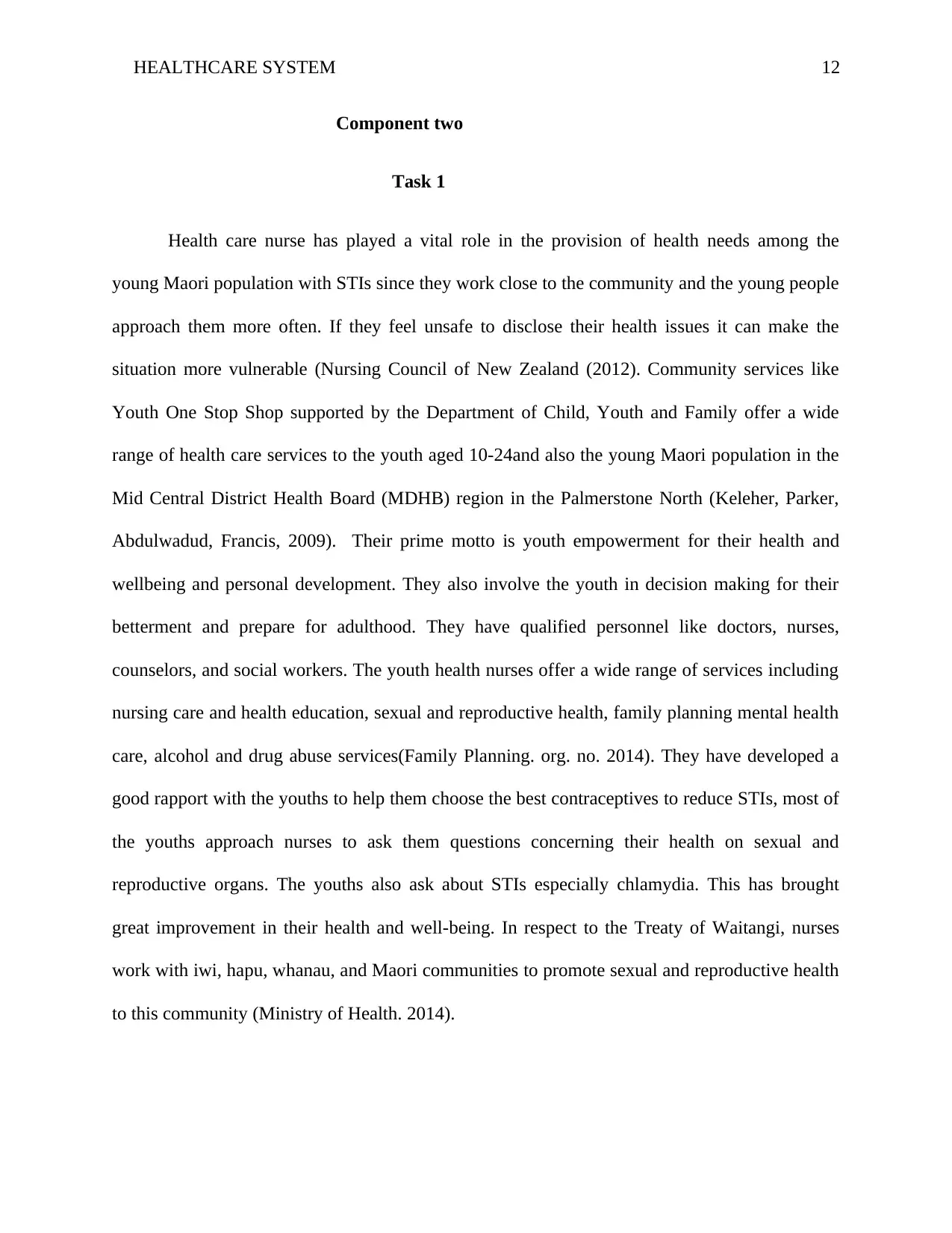
HEALTHCARE SYSTEM 12
Component two
Task 1
Health care nurse has played a vital role in the provision of health needs among the
young Maori population with STIs since they work close to the community and the young people
approach them more often. If they feel unsafe to disclose their health issues it can make the
situation more vulnerable (Nursing Council of New Zealand (2012). Community services like
Youth One Stop Shop supported by the Department of Child, Youth and Family offer a wide
range of health care services to the youth aged 10-24and also the young Maori population in the
Mid Central District Health Board (MDHB) region in the Palmerstone North (Keleher, Parker,
Abdulwadud, Francis, 2009). Their prime motto is youth empowerment for their health and
wellbeing and personal development. They also involve the youth in decision making for their
betterment and prepare for adulthood. They have qualified personnel like doctors, nurses,
counselors, and social workers. The youth health nurses offer a wide range of services including
nursing care and health education, sexual and reproductive health, family planning mental health
care, alcohol and drug abuse services(Family Planning. org. no. 2014). They have developed a
good rapport with the youths to help them choose the best contraceptives to reduce STIs, most of
the youths approach nurses to ask them questions concerning their health on sexual and
reproductive organs. The youths also ask about STIs especially chlamydia. This has brought
great improvement in their health and well-being. In respect to the Treaty of Waitangi, nurses
work with iwi, hapu, whanau, and Maori communities to promote sexual and reproductive health
to this community (Ministry of Health. 2014).
Component two
Task 1
Health care nurse has played a vital role in the provision of health needs among the
young Maori population with STIs since they work close to the community and the young people
approach them more often. If they feel unsafe to disclose their health issues it can make the
situation more vulnerable (Nursing Council of New Zealand (2012). Community services like
Youth One Stop Shop supported by the Department of Child, Youth and Family offer a wide
range of health care services to the youth aged 10-24and also the young Maori population in the
Mid Central District Health Board (MDHB) region in the Palmerstone North (Keleher, Parker,
Abdulwadud, Francis, 2009). Their prime motto is youth empowerment for their health and
wellbeing and personal development. They also involve the youth in decision making for their
betterment and prepare for adulthood. They have qualified personnel like doctors, nurses,
counselors, and social workers. The youth health nurses offer a wide range of services including
nursing care and health education, sexual and reproductive health, family planning mental health
care, alcohol and drug abuse services(Family Planning. org. no. 2014). They have developed a
good rapport with the youths to help them choose the best contraceptives to reduce STIs, most of
the youths approach nurses to ask them questions concerning their health on sexual and
reproductive organs. The youths also ask about STIs especially chlamydia. This has brought
great improvement in their health and well-being. In respect to the Treaty of Waitangi, nurses
work with iwi, hapu, whanau, and Maori communities to promote sexual and reproductive health
to this community (Ministry of Health. 2014).
⊘ This is a preview!⊘
Do you want full access?
Subscribe today to unlock all pages.

Trusted by 1+ million students worldwide
1 out of 17
Related Documents
Your All-in-One AI-Powered Toolkit for Academic Success.
+13062052269
info@desklib.com
Available 24*7 on WhatsApp / Email
![[object Object]](/_next/static/media/star-bottom.7253800d.svg)
Unlock your academic potential
Copyright © 2020–2025 A2Z Services. All Rights Reserved. Developed and managed by ZUCOL.





